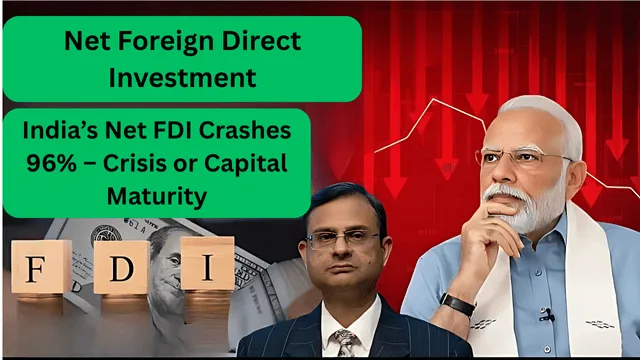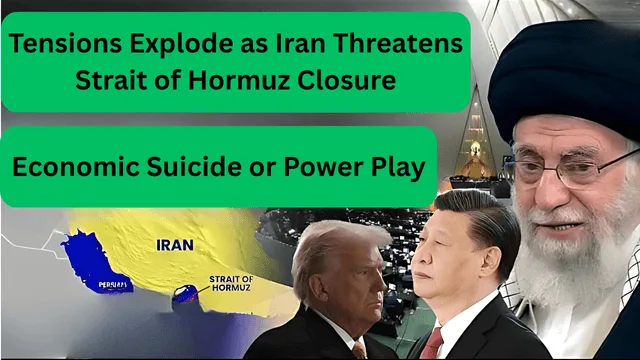Introduction: Net FDI Hits Record Low
Recently, news reports on India’s economy indicated that the country’s Net Foreign Direct Investment (FDI) has increased. We are talking about Net FDI crash in India. It has crashed by more than 96%. That means since this calculation has started. You can see this news. Net FDI inflows sink 96% to a record low. So what does this mean?
Understanding FDI and Net FDI
What is FDI?
FDI means Foreign Direct Investment. That means when money comes from abroad. Now, money can come from abroad in many ways. An individual can invest. A company can invest. A fund can invest money in India. Now this money can be invested in the Indian economy in many ways. For example, the businesses in India, factories, real estate, they invest there or the shares of companies, whether listed or unlisted.
But keep in mind that FDI is basically the money that comes in the long term. It means the money that has been invested in India for a long time by foreign countries. And it is not like, suppose you invest money in the stock market today. A person is sitting abroad who invests money today through FDI, and after 10 days, he gets a profit. He goes away with his money. That will not come under FDI. Here, basically, we talk about the long term. When money is invested in real businesses, we talk about it as Foreign Direct Investment.
What is Net FDI?
Now you have understood Foreign Direct Investment. But what is this Net FDI?
Look, it is a simple thing, which is Gross Inflow, which means whatever FDI happens. Suppose I say that $000 was invested in India in a year. Okay? As an example. But here, some money from the money that was invested earlier flowed outflow. Suppose I say $600 went out of India, then how much is the Net FDI here? It is $400.
So, what is the Gross? It is $1000. Whatever money is invested inside India in the form of FDI.
What Constitutes Outflows?
1. Repatriation of Profits
The first is Foreign Investors Repatriating Profit. Meaning, suppose if in the last few years, any foreign investor has invested their money in India, then they must have made a profit from it. For example, suppose in India, if there is the Reliance company, then there are foreign investors too, who invest in Reliance. So, here, whatever profit Reliance makes, they will also take their profit and take it outside India. So, whatever profit goes outside India, we remove it from this FDI.
2. Full Withdrawal of Investments
Apart from this, if the entire investment is withdrawn, suppose someone had invested $5000 in an Indian company, and now he is deciding to withdraw the entire amount, then when he takes the entire investment out of India, that also comes under outflow.
3. Indian Firms Investing Abroad
Also, keep in mind that the Indian companies that invest abroad, just like the foreign companies that are investing in India, we call it FDI, similarly, there will be some big Indian companies like Tata, Reliance, Adani, that also invest abroad. So, whatever investment they make, we also subtract that. So, these three things come under outflow. So, when we subtract the outflow from the gross inflow, we get net FDI.
The 2024-25 Net FDI Collapse: What Happened?
Now the question is, what has happened here in 2024-25? What is this shock? The shock is that our net FDI has crashed by 96.5%. How is this? For example, if you compare 2023-24 with 2023-24, our net FDI was $.6 billion. Okay? That’s good. $.6 billion.
But if you look at the next year, that is, the previous year, in 2024-25, that is, we call it FY 25, 2024-25. So, how much was our net FDI here? Only $353 million. I mean, just think, in the previous year, it was more than $ billion, and this house has come down to 353 million. So, how much has the downfall been?
96.5%. And since we are calculating FDI here, you must be aware that LPG reforms came in, and the economy was liberalized in 1991. If you look at it from then till now, the biggest crash has been of 96.5%, so due to this, there was a lot of discussion about it.
Why Did Net FDI Collapse?
1. High Repatriation by Foreign Investors
Look, it is not necessary to look at it in one way that 96% has crashed. It is not like that. Understand carefully here. The first thing that has happened is that massive repatriation by foreign investors has withdrawn a lot of money from the money that they had invested in India earlier. I will tell you how much they withdrew.
In 2023-24, they withdrew 41 billion. But last year, in 2024-25, in FY 25, they withdrew 49 billion.
2. Profit Booking via IPOs
And the foreign investors here have also booked their profit on the investment they had made. For example, you will remember that last year the IPO of SWGI came. Hyundai India’s IPO came. What is all this? These were very big IPOs. So what happened here was that foreign investors had invested a lot in these companies.
So it is obvious that when the IPO came, whatever profit they made here, when the shares were listed in the stock market, they sold a lot of their shares, and that is why they didn’t do anything with all this money. They took it back.
3. Increased Indian Investments Abroad
So basically, the buyback that happened here, the IPO came, due to all this, a lot of money went out of India last year. So this is a big reason why our net FDI has collapsed so much. Along with this, the Indian firms have also invested a lot abroad. The Indian companies are also expanding globally. You can see that last year, 29 billion was invested by Indian companies abroad.
Gross Inflow Still Increasing
And somewhere we do gross inflows minus outflows. So, if you look at this gross inflow, it has increased by 14%. You can see that last year it went up to 81 billion. Which was around 70 billion last year. So now it has become 81 billion. And why is this so?
Because the foreign investors have invested in India’s renewable energy, financial services, tech startups, and manufacturing. But because these outflows and repatriation here had become very high, you have seen a crash in net FDI. Maybe our net FDI could have gone negative, but still, it has been slightly positive. Well, it is not entirely negative.
Interpreting the Net FDI Crash
What I was telling you is that the crash of net FDI does not mean that it is a big shock to our Indian economy. This shows that the Indian investment story has matured a lot. The old foreign investors now feel that they should earn a profit. It is not that they will keep their money in India for their whole life. They will also take the profit. So Indian firms are also becoming global investors themselves. So this shows the maturing investment cycle. This shows confidence in the Indian economy.
If you see that the foreign investors are also taking their money back by launching IPOs. See, this is not capital flight. What is the problem when foreign investors panic? They feel that India’s economic story is going downhill. It is going down. There is a big problem in the Indian economy. So what happens suddenly? A panic situation occurs, due to which foreign investors start withdrawing their money, start exiting. So, repatriation does not mean panic selling. You have to understand this, and at the same time, as I was telling you, Indian firms are also growing internationally.
Concerns and Future Strategy
Risks of Excessive Outflows
But yes, it is not that everything is fine. We have to take care of things. Here we have to see that there is not too much outflow. The money that is going out should be limited in quantity. It should not go out suddenly. Like what happened last year, I told you, there was a 96% crash because its impact is on the value of our rupee. It affects the current account deficit. It affects the forex reserves because when a lot of money is suddenly withdrawn, all these will be affected very quickly.
Need for Diversified Sectoral Investment
Apart from this, the problem is that FDI in our country is very concentrated in some sectors. Finance is very concentrated in many sectors. The government should try to balance it. There is more FDI in other sectors as well. The long-term impact means that if suddenly a lot of money flows out, then it also affects job creation, technology, transfer, infrastructure funding, and that is why, if you see, the RBI data here also shows that the gap between gross inflow and net impact has increased a lot.
Conclusion: Structural Maturity, Not Crisis
So India must now continue policy reform so that more and more foreign capital comes and makes India more attractive for investments. Apart from this, reinvestment means that a foreign investor has invested their money. Now he is making a profit. He should earn a profit, but he should invest that money back in the Indian economy. This effort should be made, and we should incentivise more for long-term FDI.
So the conclusion is that net FDI crash in India would be a good headline. You can see in our headline what happened. But this is not a crisis. This is a profit-taking cycle by foreign investors. Indian companies are becoming global players, and structural maturity is coming in India’s capital market.
Read More Article: https://hindiakhbarr.com/national-guard-deployed-amid-explosive-immigration-crisis-los-angeles/












Leave a Reply